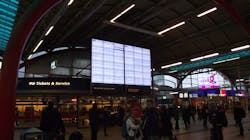Know While on the Go: How Transit Agencies Can Improve Communications
Chances are that most travelers have come across digital signage while in transit. Anyone who has checked a train’s departure time on a screen in the station or watched a live traffic report on a display at the bus terminal has viewed real-time information via digital signage — and travelers will continue to benefit from its enhanced communication benefits as it grows in usage: The compound annual growth rate of digital signage in transportation is expected to increase 18.9 percent from 2014 to 2020.
Transportation exists in a highly dynamic world and there are a number of reasons transit agencies are moving away from static signage and going digital. One major reason is the need to provide live updates to passengers or redirect people on the fly.
Digital displays are an integral part of this need, helping transit agencies quickly communicate information to customers in a more interactive way. Displays give the flexibility and fluidity a transit agency requires by making it easy to instantly swap out content by uploading it to a server — whereas a static sign can only be updated if an employee physically changes out the sign.
Because it is so much easier to instantly update, digital signage can integrate real-time data. Its functionalities allow on-the-spot updates of news, weather, emergency alerts, delays or service interruptions and wayfinding.
These real-time capabilities are especially useful in light of the security issues transit agencies face on a daily basis. During emergencies, agencies can take control of displays instantly and update the displays’ content to provide information on where passengers should go (or, sometimes just as importantly, not go) and how to contact transit police/security. Agencies can even use them to provide live commands to assist travelers — improving the speed of communications, as well as providing a safer environment for passengers.
There are three main types of digital signage: projection, liquid crystal display (LCD) screens and light-emitting diode (LED) screens. LED is the most versatile and can bring the most benefit to a transit agency.
Advantages of LED for Public Communication
LED offers benefits such as high brightness, durability and long lifecycles, allowing a transit agency to put digital signage in just about any environment.
There are several facets of LED that can be beneficial to transit agencies:
High readability: LED displays can be produced with fine pixel pitches, giving the displays new levels of clarity and picture quality. This means that transit agencies have greater flexibility with the type of content they choose to display (including font type and size), as well as where the displays are placed — travelers will be able to read them whether they are close or far away.
More effective video walls: LEDs are useful if a transit agency plans to create a video wall configuration. Unlike the standard flat-panel displays used in traditional video walls, LEDs do not have bezels (the seam around an individual display), creating a smooth, easy-to-read image.
Less maintenance/lower maintenance costs: LEDs are prone to fewer failures than LCDs or projectors, and also require less maintenance, giving busy transit officials a way to “set it and forget it.” For versions that don’t have fans or moving components inside, generally the only required maintenance is to have the front face recalibrated once or twice a year to ensure that the colors remain true.
Something to look for that can reduce future maintenance costs is an LED display that can be serviced from the front. A front-serviceable display allows maintenance workers to pull off the front panels and access the internal components without removing or pulling out the display from where it is mounted. With front serviceability, mounts don’t need to be specially designed to allow access and displays can be installed in a greater range of environments, because building structure doesn’t need to support these custom mounts.
Indoor and outdoor applications: Durable LED displays can be designed for both indoor and outdoor spaces and some can be used across both environments. Generally, an LED display that is rated for outdoor use can withstand extreme climates and temperatures, is still readable in direct sunlight, and includes an ambient light sensor, which helps achieve optimal brightness levels and minimizes power consumption.
High TCO and ROI: Total cost of ownership (TCO) has decreased in recent years as the display industry continues to invest in the technology.
Over the long term, LED offers the lowest TCO by square area of a display compared with projection or LCDs: An LED display may be a higher initial investment, but with a lifespan of up to 100,000 hours, compared with 50,000 for LCD and 20,000 for projectors, the end result is a display capable of lasting at least twice as long as other digital signage technologies.
Transit agencies’ displays will primarily be used for information or security-based content, but displays can also serve a dual purpose: Advertisements can run between information like arrival times or directions, helping to recoup some of the initial outlay of funds by bringing in revenue. This is in addition to communications updates, providing a different kind of return on investment by creating satisfied, informed travelers.
LED on the Move
There are plenty of options for communications-based digital signage, and an informed transit agency is better equipped to choose the right one for its particular applications.
An LED display gives the versatility and performance a transit agency requires when communicating to its riders, and can help position the agency as a leader in the transit space through its use of the latest technology. Customers will appreciate the up-to-the-minute-accurate information and readability, while a transit agency will recoup costs by investing in a display that is durable and low maintenance — and as LED displays continue to improve in quality and performance, the value and ROI they can offer will also continue to increase.
Grant Wylie is the senior product manager for LED at NEC Display Solutions.
